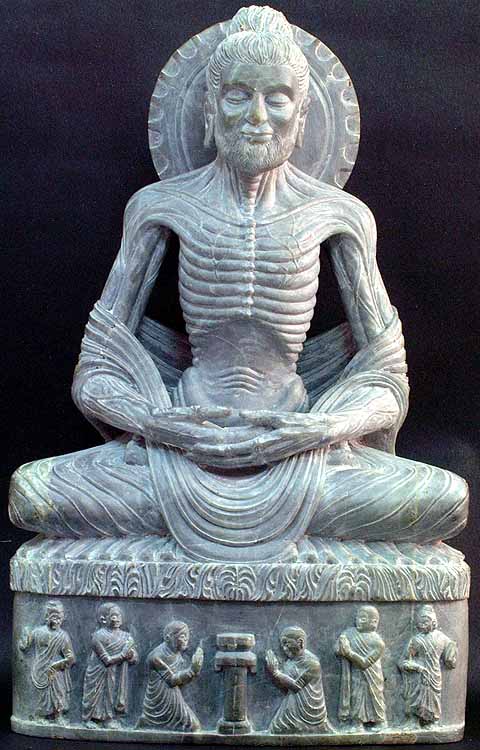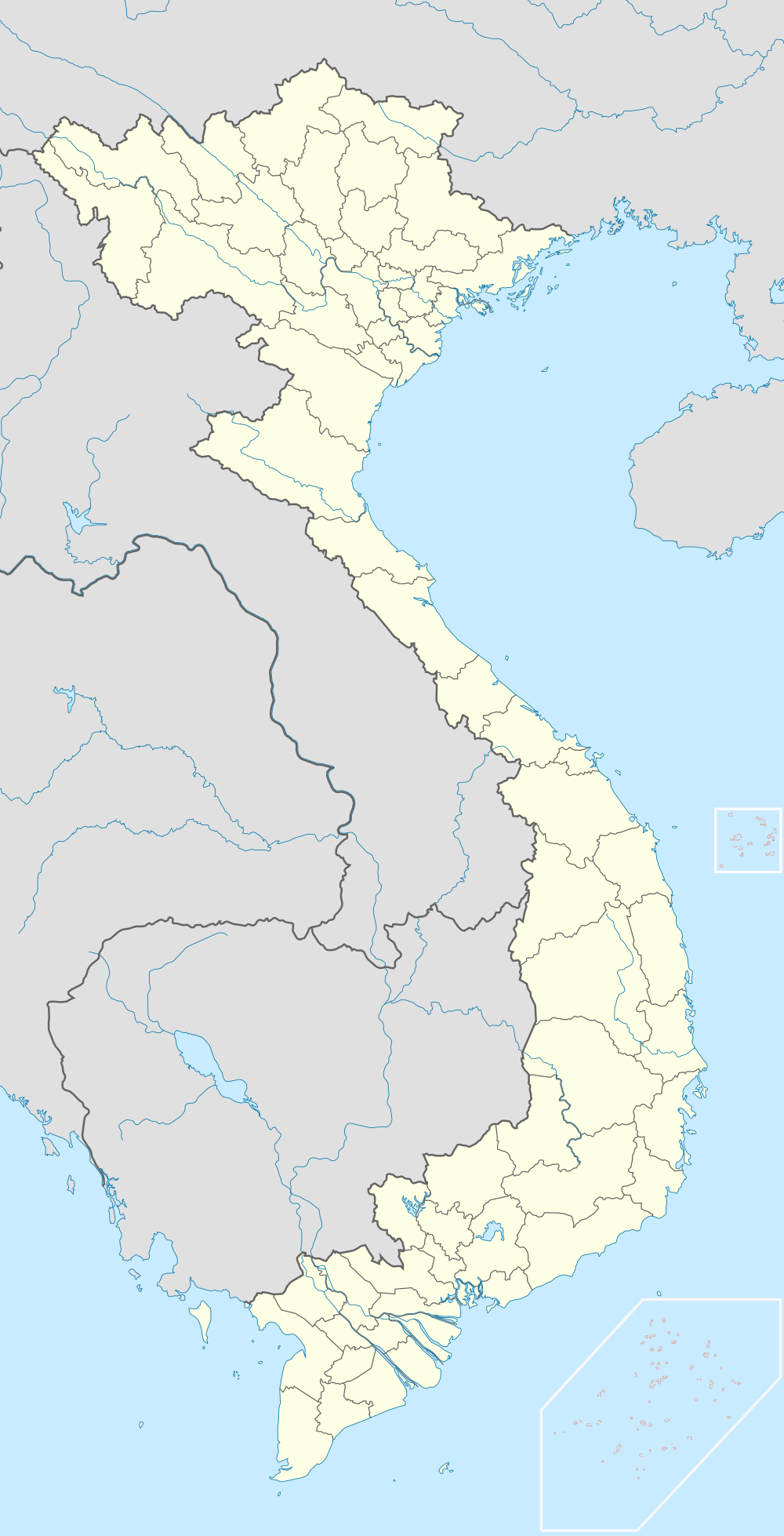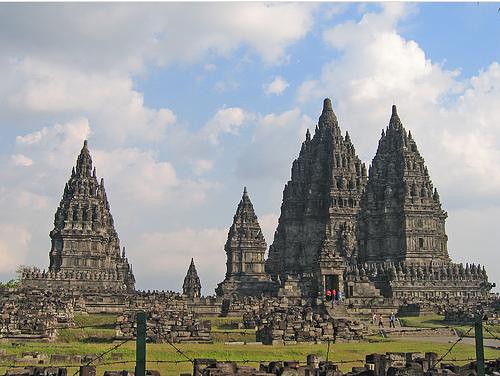Thursday, October 21, 2010
Religion and Trade in Southeast Asia
I. Threats to Vedic Hegemony
A. Jainism
1. Mahavira (540-468BCE)--known to his followers as Jina (the Conqueror), so these followers were known as Jianists, and the religion as Jianism.
2. Emphasized the holiness of the life force animating all living creatures, Mahavira and his followers practiced strict non-violence--including wearing masks so as not to accidently breath in insects, and they carefully brushed off seats before sitting down, so as not to inadvertently sit on a living creature.
3. Extreme asceticism--some followers went so far as to refuse to wear clothing (so they wouldn't have to kill plants to obtain fiber to make clothe), and ate only what others gave them--so many ended up starving to death.
a. While this seems extreme to us today--and it is--it should be noted that some early Christians chose to live as hermits--in a desert, with no clothing, only eating what they could find.
B. Buddhism--Buddha, "the enlightened one"
1. Siddhartha Gautama--born into a royal family of the Sakyan people, in the foothills of the Himalayas. Despite being born into wealth, as a young man Siddhartha abandoned his family and privileges to become an wondering ascetic
2. The Middle Path--after six years of wandering and self-deprivation, Siddhartha decided that his new lifestyle would no more lead to spiritual enlightenment than his old lifestyle of idle leisure did. Instead, his moment of enlightenment led him to seek the Middle Path.
3. Siddhartha's Enlightenment--led him to discover the Four Noble Truths--
a. Life is suffering
b. Suffering arises from desire
c. The solution to alleviating suffering lies in curbing desire
d. Desire can be curbed if a person follows the "Eighfold Path":
i. Right views
ii. Aspirations
iii. Speech
iv. Conduct
v. Livelihood
vi. Effort
vii. Mindfulness
viii. Meditation
4. Buddha's First Sermon--introduced the Wheel of the Laws, which set forth the central tenets of his philosophy.
5. Central tenets of Buddhism--focused on the individual, dismissed the usefulness of deities to a person seeking enlightenment. What mattered was practicing moderation, in order to minimize desire and therefore suffering, as well as practicing meditation and self-discipline to search for spiritual truth.
6. Nirvana--"snuffing out the flame" released one from the cycle of reincarnations, and the achievement of a state of perpetual tranquility.
7. Buddha's death--Buddha urged his followers to "be their own lamp." His teachings, memorized by his followers, spread throughout India and into Central, Southeast, and East Asia--and its success began to subvert the individualistic and essentially atheistic tenets of its founder.
a. Stupas--large earthen mounds symbolizing the universe were built over relics of the cremated founder to allow worshipers to have a connection with Buddha (like relics of the cross for Christians)
b. Bodhisattvas--men and women who had achieved enlightenment and were on the threshold of nirvana, but chose to remain among the living to assist others; this eventually developed into practices like the Dalai Lama.
8. Difficulty of the individualistic path--Hinduism won out in India because it used element of Buddhism, but also incorporated gods that people could connect to , and feel they could present their personal trouble to for resolution.
II. Southeast Asia, 50-1025CE
A. Three geographic zones
1. Indochina mainland--includes the present-day countries of Vietnam, Cambodia, Thailand, and Myanmar (Burma).
2.Malay Peninsula--Malaysia, Singapore
3. Pacific Islands--Indonesia, Philippines, Brunei
B. Agriculture--reliable rainfall because of the monsoon, coupled with consistently warm temperatures, allows Southeast Asia several growing season each year, and allows the region to support a large population. Because much of the region also sits on top of active volcanoes, they soil is high in carbon and very fertile.
1. Swidden agriculture--commonly known as "slash and burn" agriculture. The land was farmed until it was exhausted, then farmers abandoned it and let the jungle reclaim and refurbish the soil.
2. Rice--was the staple crop, but other crops were introduced to the region from other regions in Asia, including soybeans, sugar cane, yams, bananas, and coconuts, as well as domesticated animals like chickens and pigs.
C. Peopling Southeast Asia
1. Malay peoples--became the dominant population in this region and were the result of several waves of migration from southern China from around 3000BCE.
a. Some of the indigenous peoples merged with the Malays; others retreated to the mountain and forest zones. Subsequently, rising populations and disputes within communities led to streams of people leaving the mainland for the islands.
2. Navigational skills--by 1000BCE, these people had developed an awareness of the regularity of the monsoon winds, as well as the ability to use other signs, to navigate the surrounding waters--and to eventually populate islands from the Indian Ocean to the Pacific--half the circumference of the globe.
3. Northern Indochina--its proximity to China made the people living there vulnerable to Chinese pressure, and to Chines culture.
III. Trade in the Indian Ocean Maritime System
A. Origins of Contact and Trade--Sumerian records indicate trade between Mesopotamia and the Persian Gulf, Oman, and the Indus Valley. This early trade broke down, however.
1. Southern Indochina--sailors from southern Indochina sailed as far west as Mozambique, and brought with them bananas, yams, and other Southeast Asian plants.
B. Indian Ocean Ports--were often isolate from hinterlands by geographic barriers, particularly in the west (the Arabian Peninsula, the African side of the Red Sea, southern Iran, and Northern India--present-day Pakistan--were mostly barren desert.
1. Western India--has steep mountains that cut off most of the central plain from the western seacoast
2. Eastern India--was more hospitable, with denser populations. This drew traders from Southeast Asia, who brought spices and other trade goods to exchange. This in turn led Indian traders to set up shop in Southeast Asia, to both trade goods locally, and to facilitate trade with Chinese merchants.
3. Role of women--because sailors and traders were exclusively male, native females acted as cultural ciphers, and created a multi-cultural, cosmopolitan population in the Indian Ocean ports--which helped to facilitate trade.
C. Funan--the first major Southeast Asian political center was called Funan by Chinese visitors, and flourished between the first and sixth centuries C.E. Funan was centered in the Mekong Delta, in present-day southernmost Vietnam.
1. The Funan capital was located in the delta, on the southwest coast of present day Vietnam. The Mekong Delta was a "rice bowl"--meaning that is could sustain a large population because of the fertility of the soil and the growing conditions for rice.
2. The Rulers of Funan mobilized large numbers of these people to work digging irrigation channels and to prevent destructive floods. This in turn allowed them to extend control over much of southern Indochina and the Malay Peninsula.
3. Trade Routes--the early trade route between China and India was partially overland--across the Malay Peninsula--which gave the Funan rulers a great deal of control over this trade. The route was partially over land because sailing around the islands near the Malay Peninsula was dangerous, with shallow waters, shoals, and pirates.
4. Downfall of Funan--occurred in the 6th century CE, probably due to the switch to an entirely water-borne route as navigation skills improved.
D. Srivijayan Kingdom--rose during the 6th century CE, with the shift in trade route between China and India.
1. Location--the kingdom was centered at the site of the modern-day city Sumatran city of Palembang, fifty miles up the navigable Musi River. The kingdom was well-situated to control the southern part of the Malay Peninsula, Sumatra, parts of Java and Borneo, and most importantly the Straits of Malacca and Sunda--where shipping was most vulnerable on this new route.
2. Srivijayan control zones--Srivijayan rulers controlled fours disctinct ecological zones
a. Agricultural plain along the Musi River, which provided the food for the work force in the core area of the kingdom, and therefore allowed them to extend control outward.
b. Upland regions of the Sumatra interior, which was a source for commercially valuable forest products (exotic wood, in particular)
c. River ports of what had been Srivijayan rivals, which were conquered initially, and then made allies by incorporating the pirates that worked from these ports to become the Srivijan navy, in turn for a cut of the profits--and the protection the Srivijan kings could offer.
d. The "rice bowl" on the central plain of Java--a region so productive that it still houses and feeds a majority of the population of present-day Indonesia today.
3. The Theater State--like the Gupta Kingdom, the Srivijayan kings relied upon pomp, circumstance, and religious ceremony to carry off their period of rule. It was successful until trade routes again shifted--and Palembang was invaded and sacked by the Chola kingdom from southeast India in 1025CE.







No comments:
Post a Comment